
Chapter 09 Test Bank KEY
1. Linda quit her job as a loan officer at First Detroit State Bank to accept a similar position at First
Minneapolis Savings Bank. This is an example of
D. vertical mobility. AACSB: Reflective Thinking
Accessibility: Keyboard Navigation
Blooms: Remember
Difficulty: 1 Easy
Learning Objective: 09-01 Distinguish between the various types of labor mobility and explain the relative importance of each.
Topic: Types of Labor Mobility
2. Sam left his job as an auto mechanic to accept a position in his local Sears store as an auto parts
salesman. This is an example of
D. vertical mobility. AACSB: Reflective Thinking
Accessibility: Keyboard Navigation
Blooms: Remember
Difficulty: 1 Easy
Learning Objective: 09-01 Distinguish between the various types of labor mobility and explain the relative importance of each.
Topic: Types of Labor Mobility
3. If an economics professor moves from the University of California at Berkeley to the University of
Texas at Austin, that is an example of
D. geographic change/change in occupation. AACSB: Reflective Thinking
Accessibility: Keyboard Navigation
Blooms: Remember
Difficulty: 1 Easy
Learning Objective: 09-01 Distinguish between the various types of labor mobility and explain the relative importance of each.
Topic: Types of Labor Mobility
4. Approximately what percentage of U.S. workers change occupation each year?

9-2
B. 10%
D. more than 20% AACSB: Reflective Thinking
Accessibility: Keyboard Navigation
Blooms: Remember
Difficulty: 1 Easy
Learning Objective: 09-01 Distinguish between the various types of labor mobility and explain the relative importance of each.
Topic: Types of Labor Mobility
AACSB: Reflective Thinking
Accessibility: Keyboard Navigation
Blooms: Remember
Difficulty: 1 Easy
Learning Objective: 09-01 Distinguish between the various types of labor mobility and explain the relative importance of each.
Topic: Types of Labor Mobility
6. Because migration typically involves present sacrifice in order to obtain a greater stream of future
D. an impediment to economic efficiency. AACSB: Reflective Thinking
Accessibility: Keyboard Navigation
Blooms: Remember
Difficulty: 1 Easy
Learning Objective: 09-02 Use the analytical framework of human capital investment to explain the migration decision of a household.
Topic: Migration as an Investment in Human Capital
7. "Any worker for whom the present value of lifetime earnings will increase by migration will choose to
move." This statement is
losses. AACSB: Reflective Thinking
Accessibility: Keyboard Navigation
Blooms: Remember
Difficulty: 1 Easy
Learning Objective: 09-02 Use the analytical framework of human capital investment to explain the migration decision of a household.
Topic: Migration as an Investment in Human Capital
8. In the equation for the net present value of migration,
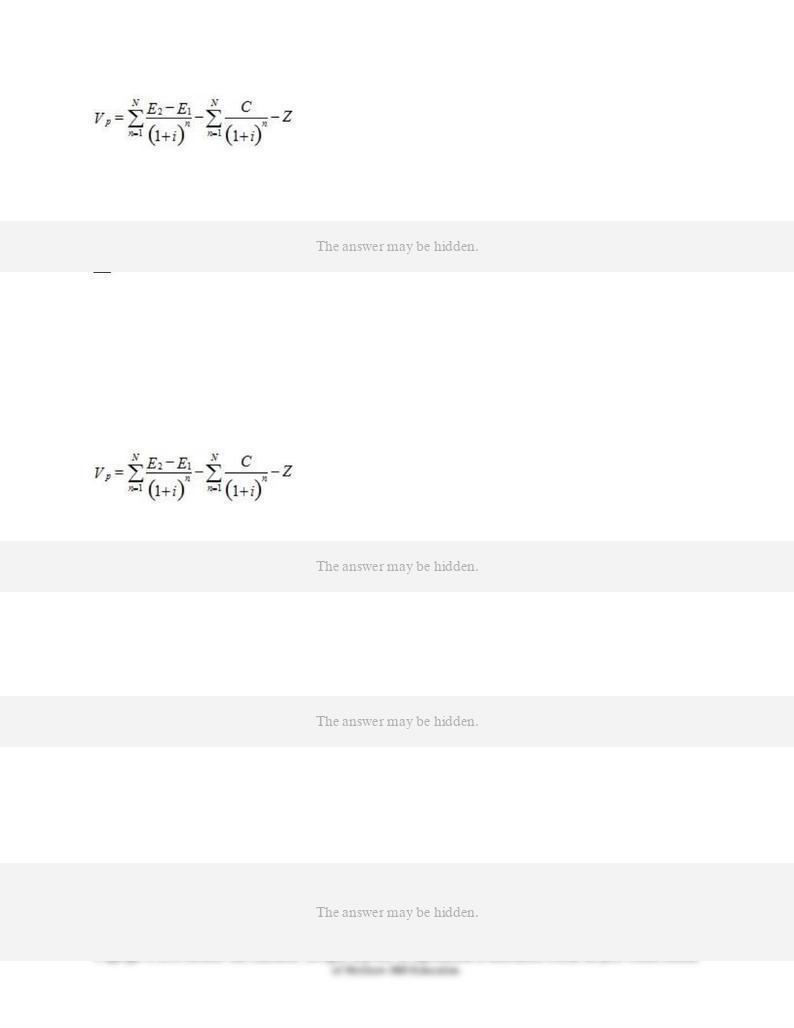
, the term “E2" refers to
D. earnings from the old job. AACSB: Reflective Thinking
Blooms: Remember
Difficulty: 1 Easy
Learning Objective: 09-02 Use the analytical framework of human capital investment to explain the migration decision of a household.
Topic: Migration as an Investment in Human Capital
9. In the equation for the net present value of migration,
, the term “C" refers to
D. the discount rate. AACSB: Reflective Thinking
Blooms: Remember
Difficulty: 1 Easy
Learning Objective: 09-02 Use the analytical framework of human capital investment to explain the migration decision of a household.
Topic: Migration as an Investment in Human Capital
D. the lower the indirect costs of migrating. AACSB: Reflective Thinking
Accessibility: Keyboard Navigation
Blooms: Remember
Difficulty: 1 Easy
Learning Objective: 09-03 Discuss the determinants of migration.
Topic: The Determinants of Migration: A Closer Look

9-4
AACSB: Reflective Thinking
Accessibility: Keyboard Navigation
Blooms: Remember
Difficulty: 1 Easy
Learning Objective: 09-03 Discuss the determinants of migration.
Topic: The Determinants of Migration: A Closer Look
12. All else equal, a worker is less likely to move
A. if the worker has moved before.
B. the greater the amount of specific training the worker has.
C. the greater the worker?s educational attainment.
D. the shorter the distance moved. AACSB: Reflective Thinking
Accessibility: Keyboard Navigation
Blooms: Remember
Difficulty: 1 Easy
Learning Objective: 09-03 Discuss the determinants of migration.
Topic: The Determinants of Migration: A Closer Look
13. All else equal, a worker is more likely to move
A. the smaller the wage differential between the destination and the origin.
B. the greater the direct costs of moving.
C. the larger the worker?s family size.
D. the lower the discount rate. AACSB: Reflective Thinking
Accessibility: Keyboard Navigation
Blooms: Remember
Difficulty: 1 Easy
Learning Objective: 09-03 Discuss the determinants of migration.
Topic: The Determinants of Migration: A Closer Look
14. All else equal, a worker is less likely to move
A. if he or she has moved before.
B. the more unionized the worker?s occupation.
C. the greater the worker?s educational attainment.
D. if the worker is single. AACSB: Reflective Thinking
Accessibility: Keyboard Navigation
Blooms: Remember
Difficulty: 1 Easy
Learning Objective: 09-03 Discuss the determinants of migration.
Topic: The Determinants of Migration: A Closer Look
15. Which one of the following helps to explain the observed relationship between age and mobility?
A. Older workers tend to have more specific human capital and on-the-job training.
B. Older workers tend to have more general training.
C. Younger workers have less time to recoup their investment costs.
D. Both direct and psychic costs of moving tend to decrease with age. AACSB: Reflective Thinking
Accessibility: Keyboard Navigation
Blooms: Remember
Difficulty: 1 Easy
Learning Objective: 09-03 Discuss the determinants of migration.
Topic: The Determinants of Migration: A Closer Look
16. Older workers are less likely to migrate, because older workers
A. have typically accumulated more possessions, raising the direct cost of moving.
B. are more likely to have to give up seniority and pension benefits.
C. are more likely to have high psychic costs of moving.
D. All of the other choices are correct.

9-5
AACSB: Reflective Thinking
Accessibility: Keyboard Navigation
Blooms: Remember
Difficulty: 1 Easy
Learning Objective: 09-03 Discuss the determinants of migration.
Topic: The Determinants of Migration: A Closer Look
17. Which one of the following will tend to decrease the perceived costs of a move relative to the
perceived benefits?
A. renting, as opposed to owning, one’s home
B. a higher unemployment rate in the destination
C. larger family size
D. increased federal grants and defense contracts in the origin AACSB: Reflective Thinking
Accessibility: Keyboard Navigation
Blooms: Remember
Difficulty: 1 Easy
Learning Objective: 09-03 Discuss the determinants of migration.
Topic: The Determinants of Migration: A Closer Look
18. Concerning the relationship between unemployment and migration, empirical studies generally find
that
A. families headed by unemployed persons are less likely than others to migrate.
B. a higher rate of unemployment at the origin raises the likelihood of out-migration.
C. a lower rate of unemployment at the destination positively affects immigration.
D. there is no relationship between unemployment and the migration decision. AACSB: Reflective Thinking
Accessibility: Keyboard Navigation
Blooms: Remember
Difficulty: 1 Easy
Learning Objective: 09-03 Discuss the determinants of migration.
Topic: The Determinants of Migration: A Closer Look
19. The average economic rate of return to migration is estimated to be
A. negative.
B. less than 5%.
C. between 10% and 15%.
D. greater than 20%. AACSB: Reflective Thinking
Accessibility: Keyboard Navigation
Blooms: Remember
Difficulty: 1 Easy
Learning Objective: 09-04 Discuss the economic consequences of labor migration.
Topic: The Consequences of Migration
20. The expected private rate of return to migration to a particular individual
A. is similar to that on other forms of investment in human capital.
B. equals that individual?s actual rate of return.
C. cannot be determined, because there are backflows in migration.
D. cannot be determined, because there are earnings disparities between the origin and the destination.
AACSB: Reflective Thinking
Accessibility: Keyboard Navigation
Blooms: Remember
Difficulty: 1 Easy
Learning Objective: 09-04 Discuss the economic consequences of labor migration.

9-6
Topic: The Consequences of Migration
21. (p. $$pageTag$$) -Early empirical evidence reported by Barry Chiswick indicated that foreign-born
persons migrating to the U.S., all else constant,
A. tended to earn more than natives from the time they arrived at the destination.
B. initially tended to earn less than natives, caught up after 10-15 years, and eventually surpassed natives.
C. typically did not catch up to the earnings of native-born workers, even after several years.
D. had little or no variance in their earnings.
AACSB: Reflective Thinking
Accessibility: Keyboard Navigation
Blooms: Remember
Difficulty: 1 Easy
Learning Objective: 09-04 Discuss the economic consequences of labor migration.
Topic: The Consequences of Migration
22. (p. $$pageTag$$) -Research by Borjas on relatively recent immigrants to the U.S. suggests that they
A. tend to earn more than natives from the time they arrive at the destination.
B. initially tend to earn less than natives, catch up after 10-15 years, and eventually surpass natives.
C. have little or no variance in their earnings.
D. typically do not catch up to the earnings of native-born workers, even after several years.
AACSB: Reflective Thinking
Accessibility: Keyboard Navigation
Blooms: Remember
Difficulty: 1 Easy
Learning Objective: 09-04 Discuss the economic consequences of labor migration.
Topic: The Consequences of Migration
23. With respect to family earnings, on the average, family migration initially
A. raises the earnings of the primary mover but reduces the earnings of the "trailing" spouse.
B. raises the earnings of wives but reduces the earnings of husbands.
C. raises the earnings of both husbands and wives.
D. reduces the earnings of both husbands and wives. AACSB: Reflective Thinking
Accessibility: Keyboard Navigation
Blooms: Remember
Difficulty: 1 Easy
Learning Objective: 09-04 Discuss the economic consequences of labor migration.
Topic: The Consequences of Migration

9-7
24. Following the downturn in air travel following the September 11, 2001, terrorist attacks, several
thousand highly paid Seattle-based union workers were laid off from airplane manufacturer Boeing. Many
of these workers left the Seattle area to accept jobs paying less than their Boeing jobs. What can we
conclude from their actions?
D. They believed that they would be better off than if they had remained in Seattle. AACSB: Reflective Thinking
Accessibility: Keyboard Navigation
Blooms: Understand
Difficulty: 2 Medium
Learning Objective: 09-04 Discuss the economic consequences of labor migration.
Topic: The Consequences of Migration
D. an increase in the size of the wage differential. AACSB: Reflective Thinking
Accessibility: Keyboard Navigation
Blooms: Remember
Difficulty: 1 Easy
Learning Objective: 09-04 Discuss the economic consequences of labor migration.
Topic: The Consequences of Migration
26. Refer to the table below. There are initially 28 workers in market A and 63 workers in market B, as
indicated by the shaded cells. All markets are assumed competitive and there is perfect information and
costless migration; jobs in markets A and B are identical in all nonwage aspects.
Given the initial situation, which one of the following may be expected to occur?
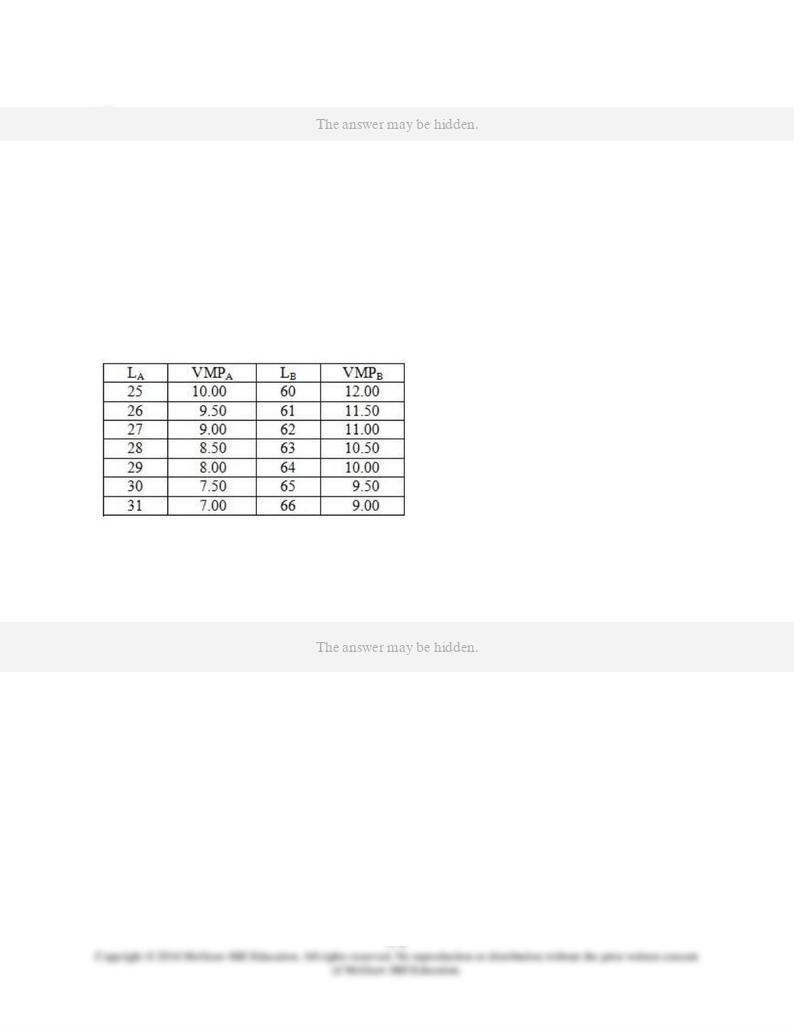
9-8
D. A migration pattern cannot be determined from the information. AACSB: Analytic
Blooms: Apply
Difficulty: 3 Hard
Learning Objective: 09-04 Discuss the economic consequences of labor migration.
Topic: The Consequences of Migration
27. Refer to the table below. There are initially 28 workers in market A and 63 workers in market B, as
indicated by the shaded cells. All markets are assumed competitive and there is perfect information and
costless migration; jobs in markets A and B are identical in all nonwage aspects.
After all adjustments to equilibrium take place in this market, we expect to find that
D. changes in the total value of output and economic efficiency cannot be determined. AACSB: Analytic
Blooms: Apply
Difficulty: 3 Hard
Learning Objective: 09-04 Discuss the economic consequences of labor migration.
Topic: The Consequences of Migration
28. Refer to the table below. There are initially 28 workers in market A and 63 workers in market B, as
indicated by the shaded cells. All markets are assumed competitive and there is perfect information and
costless migration; jobs in markets A and B are identical in all nonwage aspects.

9-9
After all adjustments to equilibrium take place in this market, the equilibrium wage ratesin markets A and
B, respectively, are
AACSB: Analytic
Blooms: Apply
Difficulty: 3 Hard
Learning Objective: 09-04 Discuss the economic consequences of labor migration.
Topic: The Consequences of Migration
29. Refer to the following diagram. Initially, wage rates are WM in Country M and WU in Country U.
Subsequent migration results in an equalization of wage rates.

9-10
Migration causes the value of output in Country M to
D. rise by WM−We. AACSB: Analytic
Blooms: Apply
Difficulty: 3 Hard
Learning Objective: 09-04 Discuss the economic consequences of labor migration.
Topic: The Consequences of Migration
30. Refer to the following diagram. Initially, wage rates are WM in Country M and WU in Country U.
Subsequent migration results in an equalization of wage rates.

9-11
Migration causes the value of output in Country U to
D. fall by WU−We. AACSB: Analytic
Blooms: Apply
Difficulty: 3 Hard
Learning Objective: 09-04 Discuss the economic consequences of labor migration.
Topic: The Consequences of Migration
31. Refer to the following diagram. Initially, wage rates are WM in Country M and WU in Country U.
Subsequent migration results in an equalization of wage rates.
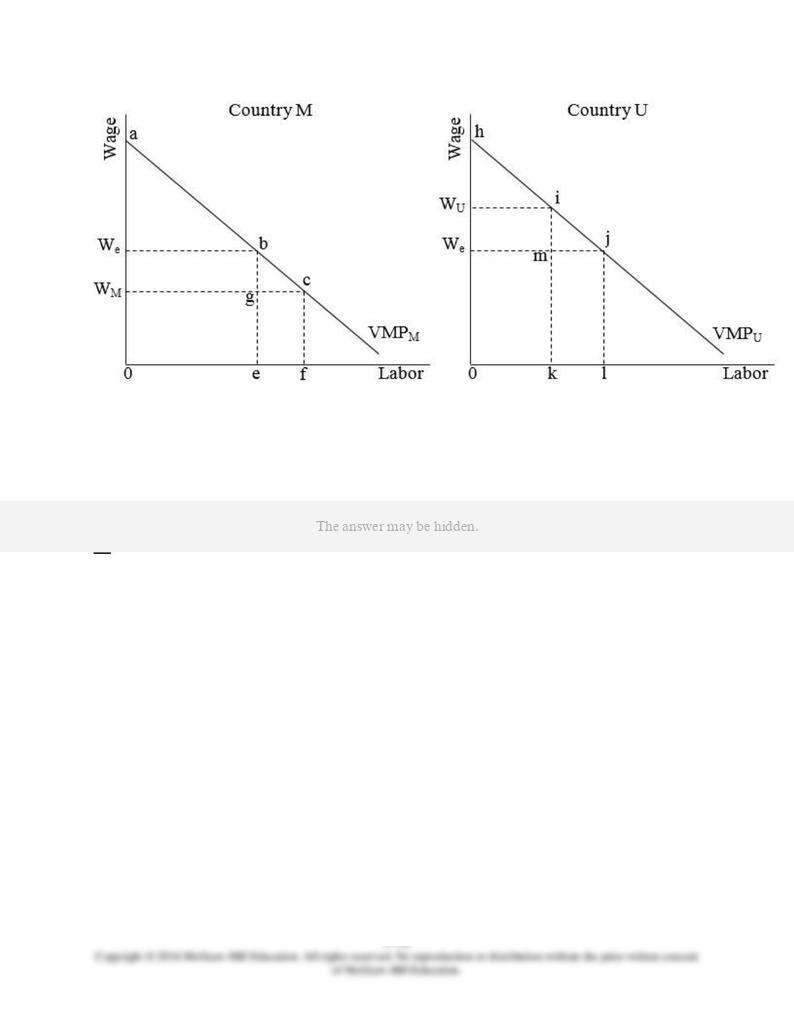
9-12
For native Country U workers, migration causes a collective loss equal to area
D. WUijWe. AACSB: Analytic
Blooms: Apply
Difficulty: 3 Hard
Learning Objective: 09-04 Discuss the economic consequences of labor migration.
Topic: The Consequences of Migration
32. Refer to the following diagram. Initially, wage rates are WM in Country M and WU in Country U.
Subsequent migration results in an equalization of wage rates.
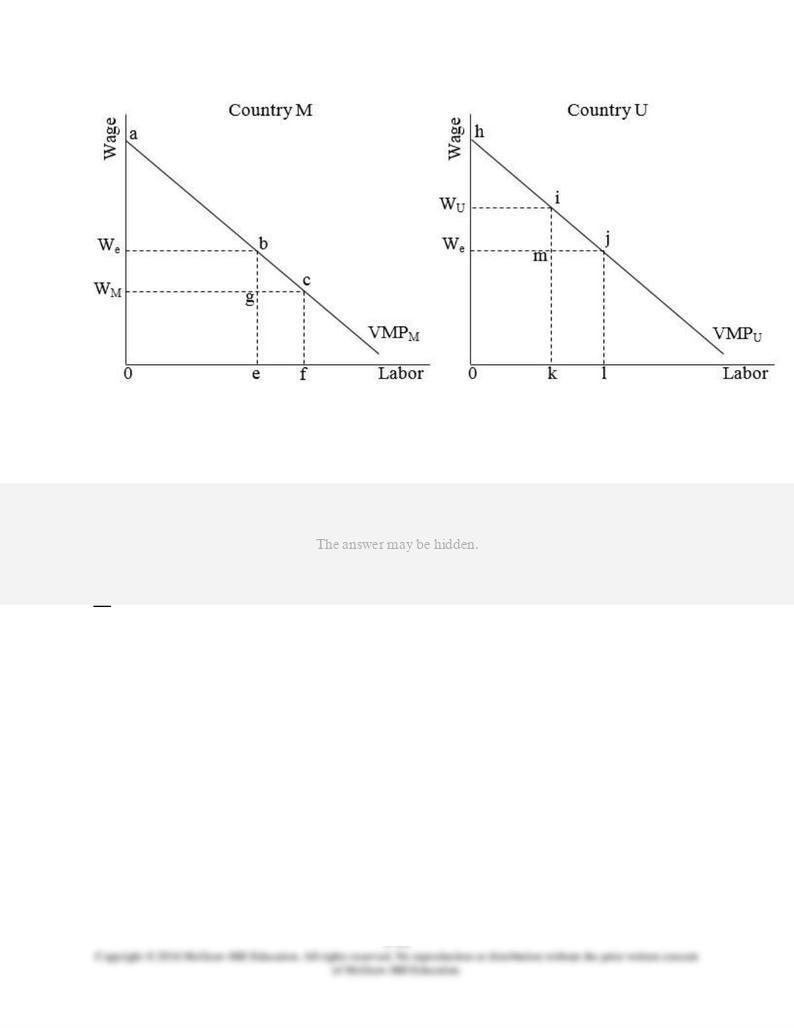
9-13
For Country M capital owners, migration causes a collective loss equal to area
AACSB: Analytic
Blooms: Apply
Difficulty: 3 Hard
Learning Objective: 09-04 Discuss the economic consequences of labor migration.
Topic: The Consequences of Migration
33. Refer to the following diagram. Initially, wage rates are WM in Country M and WU in Country U.
Subsequent migration results in an equalization of wage rates.

9-14
The combined gain in efficiency of the two countries is equal to
AACSB: Analytic
Blooms: Apply
Difficulty: 3 Hard
Learning Objective: 09-04 Discuss the economic consequences of labor migration.
Topic: The Consequences of Migration
34. Suppose a proposed law will ban migration into the United States. Considering who gains and who
loses from migration, economic theory suggests that, in general,
D. U.S. businesses would object to the law, and U.S. workers would support it. AACSB: Reflective Thinking
Accessibility: Keyboard Navigation
Blooms: Understand
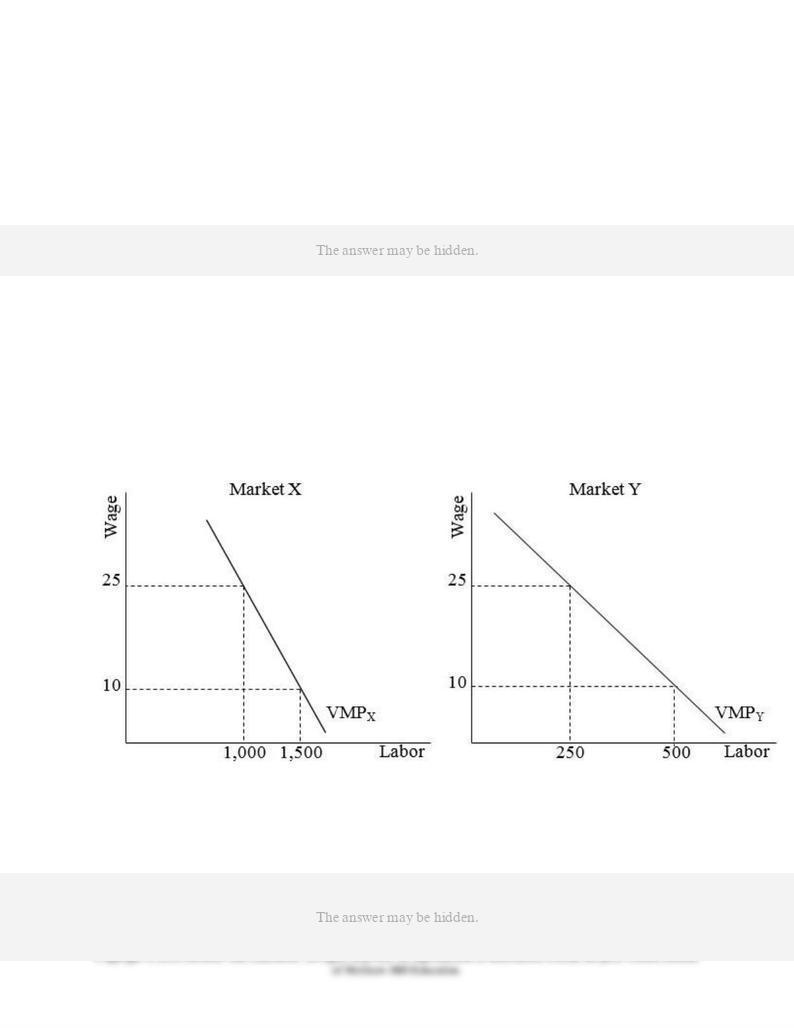
Difficulty: 2 Medium
Learning Objective: 09-04 Discuss the economic consequences of labor migration.
Topic: The Consequences of Migration
35. Suppose a proposed law will expand migration into the United States. Economic theory suggests that
there will be a net gain accruing to U.S. workers who are
D. employed in exporting industries. AACSB: Reflective Thinking
Accessibility: Keyboard Navigation
Blooms: Understand
Difficulty: 2 Medium
Learning Objective: 09-04 Discuss the economic consequences of labor migration.
Topic: The Consequences of Migration
36. Refer to the following diagram. Assume all migration is costless.
If there are initially 1,000 workers in country X and 500 workers in country Y, then we should expect

9-16
D. A migration pattern cannot be determined from the information. AACSB: Analytic
Blooms: Apply
Difficulty: 3 Hard
Learning Objective: 09-04 Discuss the economic consequences of labor migration.
Topic: The Consequences of Migration
37. Refer to the following diagram. Assume all migration is costless.
Assume there are initially 1,000 workers in country X and 500 workers in country Y. As workers begin to
migrate, the total value of output will
D. not change in either country. AACSB: Analytic
Blooms: Apply
Difficulty: 3 Hard
Learning Objective: 09-04 Discuss the economic consequences of labor migration.
Topic: The Consequences of Migration
38. Refer to the following diagram. Assume all migration is costless.

9-17
If wages are initially $10 in country X and $25 in country Y, then we should expect higher rates of capital
investment in
D. Y relative to X, eventually resulting in reduced labor demand in X. AACSB: Analytic
Blooms: Apply
Difficulty: 3 Hard
Learning Objective: 09-05 Explain how capital and product flows affect wage differentials and labor mobility.
Topic: Capital and Product Flows
39. Refer to the following diagram. Assume all migration is costless.
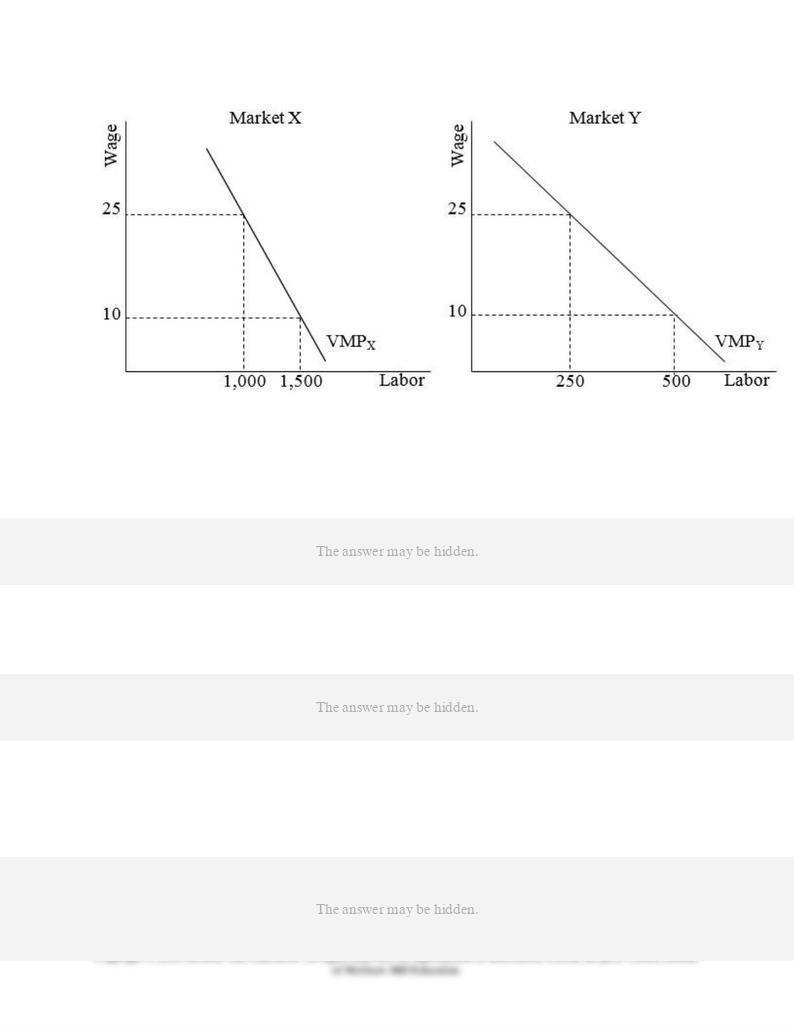
If wages are initially $10 in country X and $25 in country Y, then we should expect a relative price
advantage in country
AACSB: Analytic
Blooms: Apply
Difficulty: 3 Hard
Learning Objective: 09-05 Explain how capital and product flows affect wage differentials and labor mobility.
Topic: Capital and Product Flows
AACSB: Reflective Thinking
Accessibility: Keyboard Navigation
Blooms: Remember
Difficulty: 1 Easy
Learning Objective: 09-04 Discuss the economic consequences of labor migration.
Topic: The Consequences of Migration
41. Which of the following would be considered a real (as opposed to pecuniary) externality associated

9-19
D. Wages of destination workers will fall as migrants enter and add to labor supply. AACSB: Reflective Thinking
Accessibility: Keyboard Navigation
Blooms: Understand
Difficulty: 2 Medium
Learning Objective: 09-04 Discuss the economic consequences of labor migration.
Topic: The Consequences of Migration
participation by immigrants has decreased in recent years. AACSB: Reflective Thinking
Accessibility: Keyboard Navigation
Blooms: Remember
Difficulty: 1 Easy
Learning Objective: 09-06 Summarize the history of U.S. immigration policy and critically evaluate the economic impact of illegal immigration.
Topic: U.S. Immigration Policy and Issues
AACSB: Reflective Thinking
Accessibility: Keyboard Navigation
Blooms: Remember
Difficulty: 1 Easy
Learning Objective: 09-06 Summarize the history of U.S. immigration policy and critically evaluate the economic impact of illegal immigration.
Topic: U.S. Immigration Policy and Issues
44. Estimates by the U.S. Bureau of the Census suggest that since 1992, total legal and illegal
D. 12,000,000 persons. AACSB: Reflective Thinking
Accessibility: Keyboard Navigation
Blooms: Remember
Difficulty: 1 Easy
Learning Objective: 09-06 Summarize the history of U.S. immigration policy and critically evaluate the economic impact of illegal immigration.
Topic: U.S. Immigration Policy and Issues
Act. AACSB: Reflective Thinking
Accessibility: Keyboard Navigation
Blooms: Remember
Difficulty: 1 Easy

9-20
Learning Objective: 09-06 Summarize the history of U.S. immigration policy and critically evaluate the economic impact of illegal immigration.
Topic: U.S. Immigration Policy and Issues
AACSB: Reflective Thinking
Accessibility: Keyboard Navigation
Blooms: Remember
Difficulty: 1 Easy
Learning Objective: 09-06 Summarize the history of U.S. immigration policy and critically evaluate the economic impact of illegal immigration.
Topic: U.S. Immigration Policy and Issues
47. Suppose there is an increase in immigration rates of unskilled, illegal aliens.Which of the following is
AACSB: Reflective Thinking
Accessibility: Keyboard Navigation
Blooms: Understand
Difficulty: 2 Medium
Learning Objective: 09-06 Summarize the history of U.S. immigration policy and critically evaluate the economic impact of illegal immigration.
Topic: U.S. Immigration Policy and Issues
48. Refer to the following diagram, in which Sd is the supply curve of domestic labor and St is the total
labor supply curve including the supplies of illegal immigrant workers. L is measured in thousands of
workers.
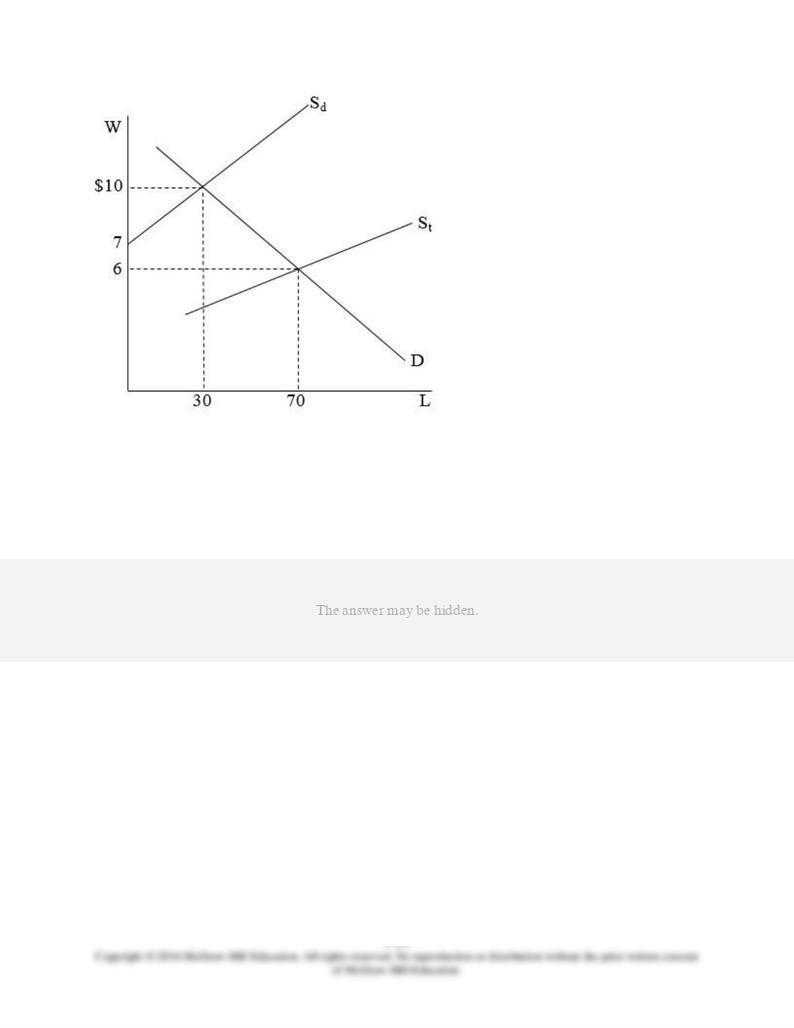
9-21
Consider the market depicted in the diagram. Supporters of illegal immigrants claim that no domestic
workers are willing to do this type of work. Their claims are
D. true. AACSB: Analytic
Blooms: Apply
Difficulty: 3 Hard
Learning Objective: 09-06 Summarize the history of U.S. immigration policy and critically evaluate the economic impact of illegal immigration.
Topic: U.S. Immigration Policy and Issues
49. Refer to the following diagram, in which Sd is the supply curve of domestic labor and St is the total
labor supply curve including the supplies of illegal immigrant workers. L is measured in thousands of
workers.
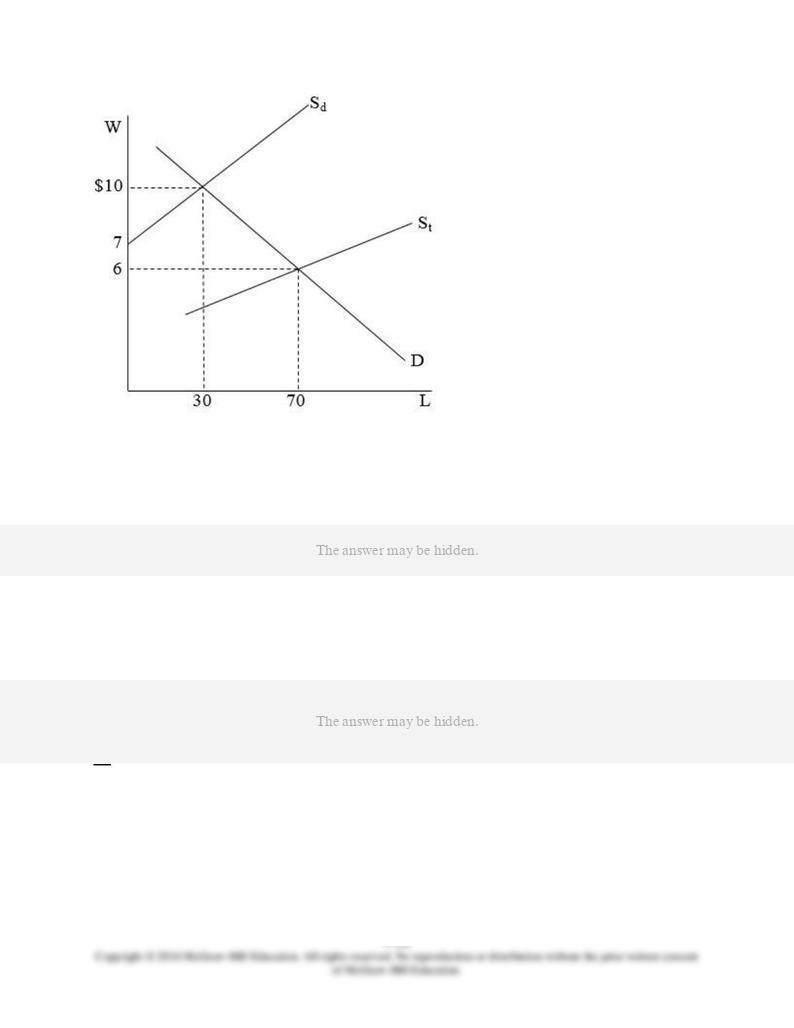
9-22
Consider the market depicted in the diagram. If all illegal aliens were deported,
D. the wage would remain at $6, and there would be a shortage of 40,000 workers. AACSB: Analytic
Blooms: Apply
Difficulty: 3 Hard
Learning Objective: 09-06 Summarize the history of U.S. immigration policy and critically evaluate the economic impact of illegal immigration.
Topic: U.S. Immigration Policy and Issues
the government prosecute the traffickers. AACSB: Reflective Thinking
Accessibility: Keyboard Navigation
Blooms: Remember
Difficulty: 1 Easy
Learning Objective: 09-06 Summarize the history of U.S. immigration policy and critically evaluate the economic impact of illegal immigration.
Topic: U.S. Immigration Policy and Issues
Chapter 09 Test Bank Summary
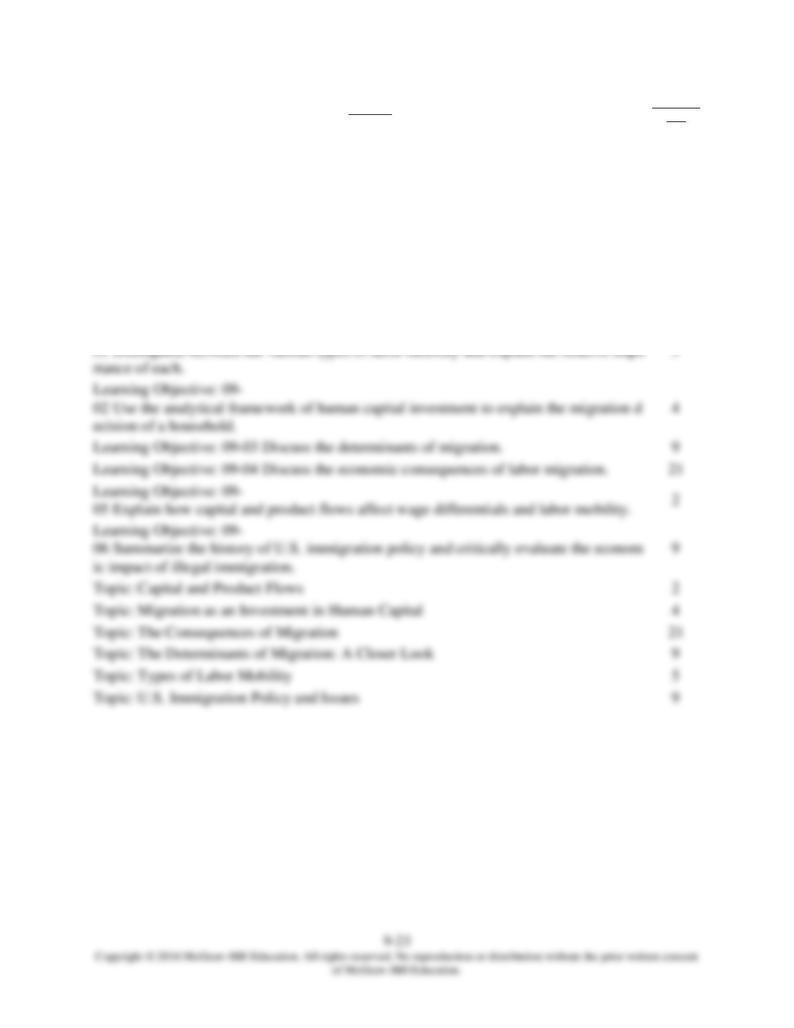
Category
# of Quest
ions
AACSB: Analytic
14
AACSB: Reflective Thinking
36
Accessibility: Keyboard Navigation
34
Blooms: Apply
14
Blooms: Remember
31
Blooms: Understand
5
Difficulty: 1 Easy
31
Difficulty: 2 Medium
5
Difficulty: 3 Hard
14
Learning Objective: 09-